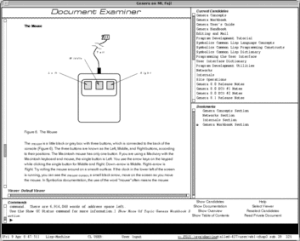|
Symbolics Document ExaminerSymbolics Document Examiner is a powerful and early hypertext system developed at Symbolics (a manufacturer of high-end workstations) by Janet Walker in 1985. The Symbolics Document Examiner was first used for a hypertext implementation of the Symbolics manual in the sixth release of the Genera operating system, and was well liked, winning an award from the Society for Technical Documentation.[1] History The Symbolics manual was an 8,000-page document that was represented in a 10,000-node "hyperdocument" containing 23,000 links in all. The entire manual required 10 MB of storage space - a significant amount in 1985, even on the Lisp machines Symbolics sold. The Symbolics Document Examiner used a hierarchical structure, which differed from other experimental hypertext systems; it apparently was partially inspired by an even earlier hypertext system, the precursor to Texinfo which originated with Emacs.[2] Symbolics Document Examiner users could add bookmarks, which allowed returning to specific items easier; this method was later incorporated in graphical web browsers. The system also supported on-line substring searching. The biggest drawback to the Symbolics Document Examiner was that users could not make changes to any information or to a document's navigation. The authoring environment for the Document Examiner was Symbolics Concordia. With Symbolics Concordia it was possible to edit all documentation. References
External links
|